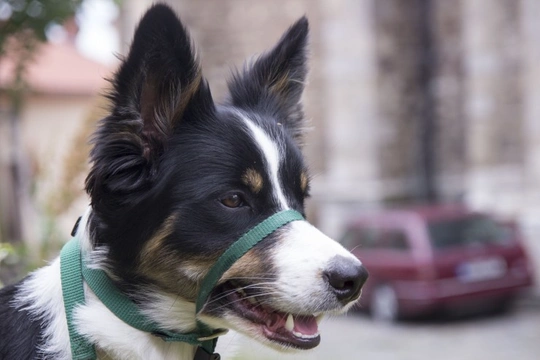
Halti Headcollar for Puppies: Age, Fitting & Use
The Halti headcollar, and other equivalents sold under different names have become a reasonably common sight in the UK, as many dog owners find that a Halti provides more control and helps to curb pulling on the lead better than a standard collar or harness.
However, they are not a magical cure-all for solving on-lead problems or controlling unruly dogs, and they are not suitable for all dogs either. The added control provided by a Halti provides benefits for the owner, but in some cases if used wrongly or for the wrong reasons, can be overly restrictive and potentially, cause problems for the dog.
Often, training and behavioural modification can correct the types of problems that a Halti is designed to manage-and these should be explored first, before buying a specific piece of kit to change the way your dog responds and walks on the lead.
For new puppy owners who are beginning to train their dogs to walk to heel and to behave appropriately on the lead, pulling is a very common problem-which may potentially be solved with the use of a Halti-style collar. However, they are by no means the only or even best option for all pups that pull, and puppy owners should think carefully before using a Halti on a puppy, as well as being clear about its benefits and limitations, and potential problems.
In this article, we will look at whether or not you can-or should-use a Halti on a puppy, some of the plusses and minuses of doing so, and alternative options to explore. Read on to learn more.
What is a Halti?
A Halti is an accessory for walking dogs, like a collar, lead or harness. The Halti is constructed of two sections, one of which goes around the neck and the other around the dog’s nose and muzzle, which means that they are not generally suitable for very flat-faced dog breeds like the pug.
Your dog’s lead attaches to the collar part of the Halti, and when you provide feedback in the form of pressure on the lead, this pressure passes to the muzzle of the Halti as well as the dog’s neck, producing a firmer form of direction than using a collar or harness alone. Additionally, when your dog pulls on the lead, this too creates pressure on the Halti muzzle, helping to restrain and check your dog and discourage pulling.
What sort of dogs can benefit from using a Halti?
The Halti is aimed at dogs that are very strong and/or that pull hard on the lead, which makes walking them a struggle in terms of retaining control and avoiding being pulled around. The pressure produced on the Halti discourages pulling and provides clearer feedback to the dog, making them check their pace and pulling behaviour, and making them walk ore calmly with less pulling.
Puppies, training and Halti headcollars
Halti headcollars are designed to make walking dogs that pull on the lead easier and better controlled, and can be a valuable tool for dog owners who have otherwise failed to address pulling or that need a little extra control due to their dog’s size or strength.
However, pulling on the lead is a behavioural problem, and while the Halti can help to recondition the dog’s responses to make them less likely to pull, retraining and behaviour modification should also be considered to improve the dog’s responses without the need for tools and accessories.
Training a puppy to walk on the lead and not pull excessively can be a challenge, but it is also an important part of properly training your pup to head off and tackle potential problems early on, before they become set for life and so, harder to resolve.
Going back to basics and redirecting pulling in younger dogs is usually a more appropriate option than integrating a Halti collar to restrict the dog’s behaviour-although there are applications for Halti use as part of training.
A Halti produces pressure on the muzzle and neck when in use that can potentially run the risk of causing harm or damage to a young dog’s growing and developing bones and muscles, as well as potentially changing your pup’s behaviour on the lead for the worse-such as by leading to negative associations with on the lead walking, or inappropriately subduing their behaviour.
No dog owner should pull or yank on the dog’s lead, but with a Halti and particularly, when used on a puppy, this is even more important, because of the risk of causing harm, as well as making the dog uncomfortable or unhappy about walking.
When it comes to starting off on the lead walks with a puppy, they are highly likely to pull-but beginning in the right way and correcting the pulling from the get-go, refusing to proceed until the dog relaxes and walks normally, can avoid making pulling an integral part of on the lead walks in the adult dog.
Integrating a Halti into your training sessions when the pup has shown a propensity to pull can help with curbing this behaviour before it becomes established, but in younger dogs, a Halti should be viewed as a training tool or aid that has a specific purpose and is intended to aid with training, not avoid it.
The decision to use a Halti with a puppy should be made carefully, taking into account the need for behaviour and training direction as well, and ideally, be made with the intention to use the Halti to aid with behaviour correction and training for a short period of time, rather than using a Halti for life.
Additionally, a pup that is only used to being walked or trained with a Halti may behave differently and be more apt to pull and be unruly when you simply use a collar or harness, so only integrate a Halti into training for set purposes, and with great care.



